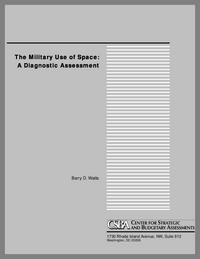
The principal aim of this report is to assess the evolving capabilities of nations and other actors to exploit near-earth space for military purposes over the next 20-25 years. The broad thrust of the assessment can be encapsulated in the following judgments:
- At the dawn of the 21st century, the preeminent user of near-earth space for military purposes is the United States, and the preeminent American use of space is to support operations by traditional air, sea and land forces within the earth’s atmosphere. For the United States, the military value of orbital systems rests almost exclusively in force enhancement rather than force application, whether the term “force application” is construed in the narrow sense of space-to-earth strikes or broadly enough to include space control.
- The United States is currently far ahead of any other nation in the capability to exploit orbital systems for the enhancement of terrestrial military operations. However, American requirements for global power projection suggest the United States is also more dependent on space systems than other countries, and future opponents may be able to offset many of the advantages the American military derives from space without a major space program.
- The 1990s were a period of transformation in how the American military uses space systems to support terrestrial military operations. Whereas US space efforts had concentrated on the pre-conflict aspects of central nuclear war and the military competition in central Europe during 1957–91, over the last decade the US military has sought to redirect its space efforts toward the real-time enhancement of ongoing, nonnuclear military operations within the earth’s atmosphere.
- While the American military is currently far ahead of other militaries—friendly ones as well as those of potential foes—in the ability to exploit information from space systems during current operations, even the United States has probably realized no more than a small fraction of space’s potential for force enhancement.
- The near-monopoly on access to advanced orbital systems and capabilities that the US and Soviet governments enjoyed during the Cold War is rapidly coming to an end, and the large margin of relative military advantage access has given the United States in particular is likely to grow harder to sustain in the years ahead. One thing that may prove more important than access to dedicated military space systems may be the rates at which various militaries are able to incorporate commercial and dual-use technologies driven by market forces rather than government programs. In this area, the US military may be far more constrained bureaucratically than many of its prospective adversaries.
- Presuming that no other nation acquires both the resources and the strategic imperative to field space-based weapons, there is a better-than-even chance that the predominant military use of near-earth space will remain force enhancement through 2020–25 rather than becoming an arena of overt military competition, much less an actual battleground. Yet, it is not difficult to imagine trigger events, as well as more gradual paths, that could prompt an earlier-than-expected transition of near-earth space from a force-enhancement to a force-application role. Indeed, if force application is construed broadly enough to include terrestrial- based applications of military force aimed at affecting orbital systems and their use, one can argue that space warfare has already arrived even though no space-based weapons are currently deployed.
- The strategic logic of space power argues that weapons will one day be based in near-earth space because nations will eventually feel compelled to defend their strategic interests there by fielding military capabilities to control orbital space. However, that day may lie further in the future than is generally thought, especially by space enthusiasts.



























